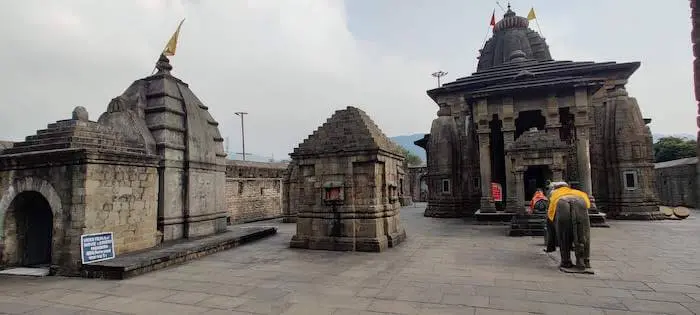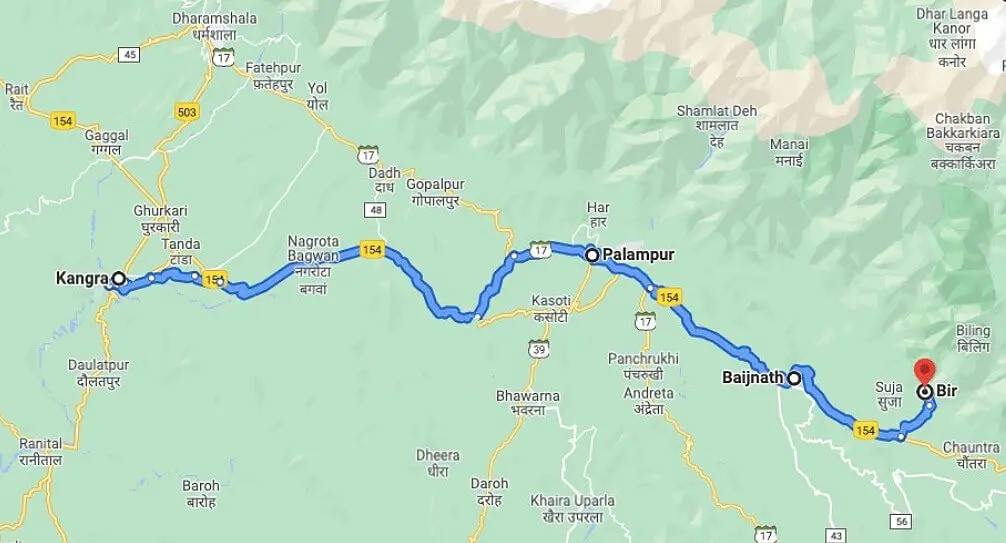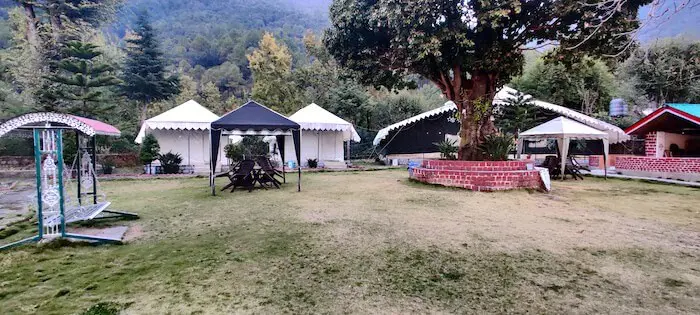Famous Baijnath Temple Himachal Pradesh – Baijnath Mandir ( Ardhnarishwar Jyotirling Dham )
The mystical, ancient and famous Baijnath Temple is located near the banks of the river Binwa in a town with the same name in the Kangra District of the state of Himachal Pradesh in northern India. As with most Shiva temples in India, the Baijnath Mandir is surrounded by fascinating legends and myths.
Ancient & Famous Baijnath Temple Himachal Pradesh | Baba Baijnath Dham
Famous Baijnath Temple History
The history of the Baijnath Temple of Himachal Pradesh is traced from the inscriptions found inside the temple. These can be seen in the main hall or Mandapa of the temple. The inscriptions are in Sanskrit and the local Pahari language. According to the official website of the temple, the temple was constructed by two brothers Manyuka and Ahuka, who lived in the region which was then known as Kiragrama.
According to the inscriptions the famous Baijnath temple was built in Saka 1126 which converts to 1204 CE in the Gregorian calendar. However, though the temple was constructed by the two brothers, the inscriptions also point out the existence of the Shivlinga that was called Vaidyanatha even before the construction of the temple.
There is no documented history after this. However, inscriptions on the wooden door of the Garba Griha, tell about the renovation and repair of the temple in the 18th century by Sansara Chandra II, the Katoch king who ruled over the Kangra region in those times.
On the 4th of April, 1905, the Kangra region was rocked by a massive earthquake that measured 7.8 on the Surface Wave Magnitude Scale. More than 20,000 people lost their lives and most of the buildings in the region including those in Mcleod Ganj, Dharamshala, and Kangra were either destroyed or damaged.
J.Ph.Vogel, who was a Dutch Sanskrit expert and an epigrapher, and was working with the Archaeological Survey of India between 1901 and 1914, has documented the damage to the Baijnath Temple in his reports. The outer walls were damaged in the earthquake, however, the main shrine and the main hall including the Garba Griha seem to have miraculously escaped the fury of the quake.
The damage caused to the temple in the earthquake was later repaired. Worship at the temple continues to be performed according to prescribed rituals by the hereditary priests who have been officiating for many generations.
Ancient & Famous Baijnath Temple Story And Legends
There are many interesting stories and legends that surround the Baijnath temple and the sacred Baijnath Shivling. These legends connect the temple and its deity with two of the great Indian mythologies Ramayana and Mahabharata.
According to the official website of the ancient and famous Baijnath Temple, during the Tretayuga, Ravana the King of Lanka was a staunch devotee of Lord Shiva. He did rigorous penance to the Lord at Kailash. However, when his penance did not yield any result, he proceeded to a place called Kurah which is believed to be present-day Manimahesh in the Chamba District of Himachal Pradesh.
Once in Kurah, Ravana intensified his penance and started sacrificing his 10 heads. The Devas who were alarmed at the consequences of Ravana attaining divine powers because of his penance, beseeched Lord Shiva to stop him. Lord Shiva appeared before Ravana and pacified him and also healed him by restoring his heads.
Thus Shiva came to be known as Vaidyanatha. Ravana asked Shiva to accompany him to Lanka so that he could consecrate him there. Shiva bowed to the wishes of Ravana and assumed the form of a Linga in two parts. The only condition that Shiva had for Ravana was not to place the Shivaling on the ground.
Ravana carried the Shivalinga and proceeded towards his kingdom of Lanka. However, when he reached the region of Gokarn (Baijnath), he felt the need to relieve himself. He found a cowherd in the vicinity and handed over the Shivling to him to hold for a while.
When he returned the Shivling was on the ground and the cowherd had fled. Thus the Shivling got established in Baijnath, one half as Vaidyanath and the other as Chandrabhal.
he above story of Ravana and Shiva is similar to the one associated with the Sri Mahabaleshwara Swamy Temple Gokarna in the state of Karnataka.
It is also believed that the Pandavas had established a big city with a Shiva temple in the region, and the Baijnath Siva Mandir is that very temple. The city and the temple were probably destroyed by some natural catastrophe. The Shivling however must have survived the wrath of nature, and a temple was built over it again by the two brothers Manyuka and Ahuka.
Baijnath Temple Mystery | Baijnath Jyotirling?
There are 12 Jyotirlingas across India and some believe that Baijnath is a Jyotirling too. However, it is generally accepted that the “Srividyanatham,” referred to in the Dwadasha Jyotirlinga stotra of Adi Shankaracharya is the one in Deoghar in the state of Jharkhand.
“Poorvothare prajwalika nidhane
sada vasantham girija sametham
surasuraradhitha padapadmam
srivaidyanatham thamaham namami”
-From Adi Shankaracharya’s Dwadasha Jyotirlinga Stotra
According to the Stotram of Adi Shankaracharya, the Srivaidyanatham being referred to is in the north-east direction. The Baba Baidyanath temple in Deoghar Jharkhand fits this description and hence is considered one of the 12 Jyotirlingas.
The dispute over this also includes another Shiva Temple in Maharashtra, the Parli Vaijnath temple, which many believe to be a Jyotirlinga temple. However, suffice to say, that irrespective of being a Jyotirlinga or not, the Baidyanath temple in Himachal Pradesh is surrounded by the divine aura of Lord Shiva.
Baijnath Temple Kangra Himachal Pradesh Architecture

The famous Baijnath Temple is a pleasing visual sight with its symmetric design juxtaposed against the beautiful backdrop of mountains. The temple is built in the Nagara style of temple architecture.
The temple complex is enclosed by a stone wall that runs around its perimeter. The wall measures about 120 feet in length and 60 feet in width on the eastern side and about 75 feet on the western side.
The temple is on an east-west axis and is oriented towards the west. It has all the elements of the Nagara style of temple architecture that is prevalent in Northern India. The entire temple is built on a raised platform, and one enters the compiled by a small flight of stairs.
A Nandi stands facing the main entrance in stark relief. The standing Nandi is a feature of many Shiva temples in the north, especially Himachal Pradesh.
Right in front of the standing Nandi is a small pavilion supported by four columns at the corners. Inside this pavilion is the sculpture of a seated Nandi. A unique aspect of this Nandi which we have never come across is the figure of a man hanging by its tail. The same feature can be seen in the standing Nandi too, however, it is very prominent in the sitting Nandi.
After the pavilion with the sitting Nandi, there is another small porch, the entrance porch or the Ardha Mandapa, which is supported by four ornate columns. The Ardha Mandapa leads to the Mandapa or main hall in front of the Garbha Griha or Sanctum Sanctorum.
Inside the Mandapa are the faded inscriptions that provide a window to the ancient history of the temple. The Mandapa is topped with a ceiling that is embellished with ornate beams. The Garbagriha is crowned with a Shikhara crowned with an Amalaka and Kalasha. On the southern and northern sides of the Mandapa are beautiful balconies supported by ornate columns.
The main temple of Shiva is surrounded by smaller shrines and open pavilions with deities. One of the important shrines that stands diagonally in front of the main shrine is a small temple dedicated to Radha and Krishna. There are some other small structures that were damaged in the earthquake of 1905 and are believed to have been rooms of the priests who served in the temple.
The outer walls of the temple are decorated with carvings of Hindu deities and Hindu iconography, while there are many sculptures in the niches of the outer walls too.
Sculptures In Baba Baijnath Mandir
Some of the notable images in the niches include those of Shiva and Parvati, Brahma, Ganesha, Kuber, Saraswati, Shiva as Ardha Narishwar, Lakshmnarayan, Ganga, Durga, and Surya.
Intriguing Mysteries of Ancient Baijnath Temple In Himachal Pradesh
Here are some amazing mysteries associated with the Baijnath Mandir in Himachal Pradesh, that adds to the enigma of the temple.
- The festival of Dassara in which an effigy of Ravana is burnt is not celebrated in Baijnath as Ravana is considered to be one of the most ardent devotees of Shiva
- There are no goldsmith or silversmith shops in Baijnath, whenever someone has tried to start this business, they have failed, this fact too seems to be related to Ravana
- The Shivling inside the Baijnath Shivling temple is believed to extend a long-long way into the bowels of the earth
- Once a king from Mandi wanted to take the Shivling with him but in spite of digging deep the workers could not reach the end of the Shivling and were attacked by strange-looking bees
- The repentant king realized his mistake and had the Shivling decorated with butter since then the Shivling has been decorated with large amounts of butter for seven days during the festival of Makar Sankranti
- A beautiful white mouse has been spotted near the sculpture of Ganesh in the temple, no one knows from where it comes and where it disappears
- On the image of Shiva and Parvati near the Radhakrishna temple, a small cobra or Nag materializes from time to time
- According to the hereditary priest of the temple, their forefathers used to chant, “Om Naman Shivaya,” in the mornings when they came to open the temple and the temple doors used to open automatically
The ancient temple of Baijnath is located in picturesque surroundings. It is located by the side of a highway, and from the road, one does not expect the pleasant sight that greets you when you reach the precincts of the temple.
Behind the temple flows the Binwa river, making its way amidst rocks and pebbles, against the backdrop of lush green hills.
There are many places near Baijnath that you can include in your Himachal Pradesh itinerary. Here is a list of some of the important places to visit near Baijnath with distance.
- Chamunda Devi Temple – 36 kilometres
- Masroor Rock Cut Temples – 90 kilometres
- Andreta – 12 kilometres
- Dharamshala – 51 kilometres
- Mcleodganj – 60 kilometres
- Palampur – 17 kilometres
- Bir – 13 kilometres
- Mandi – 75 kilometres
- Parashar Lake – 107 kilometres
- Khajjar – 163 kilometres
- Dalhousie – 161 kilometres
Baijnath Map | Baijnath Himachal Pradesh Map
Here is the map of Baijnath in Baijnath, Kangra, Himachal Pradesh.

How To Reach Baijnath Shiv Mandir | Baijnath Mahadev Temple

Click here for directions.
- Baijnath Temple is located in a town named Baijath in the Kangra district of Himachal Pradesh in India
- Baijnath is located right on the National Highway that connects Pathankot and Mandi
- Baijnath Shiv Mandir Address is, Shiv Mandir, Baijnath, Himachal Pradesh – 176125
- Baijnath to Kangra distance is about 53 kilometres
- Baijnath to Dharamshala distance is about 51 kilometres
Reaching The Famous Baijnath Temple Himachal Pradesh By Air
The nearest airport to Baijnath is in Pathankot at a distance of about 129 kilometres. There are flights to and from Delhi and Jaipur. Please check respective airports and airlines for updated flight schedules.
Reaching The Ancient & Famous Baijnath Temple Himachal Pradesh By Rail
Baijnath has a railway station that is less than a kilometre from the Baijnath Shiv Mandir. Trains to and from Pathankot and Jogindernagar pass through the station. The Railway station code of Baijnath Mandir Railway station is BJMR.
Reaching The Famous Baijnath Temple Himachal Pradesh By Road
Baijnath is located right by the side of the highway connecting Pathankot and Mandi. One can travel to Baijnath from anywhere by road. We travelled by road from Amritsar, via Pathankot, Dalhousie, and Dharamshala.
If you are planning your Himachal Pradesh itinerary and visit to Baijnath, you can book your flight tickets right here through, TripAdvisor or CheapAir or Cleartrip or Makemytrip or Priceline and fly to Pathankot or Amritsar. If you are thinking of a road trip, do check out the rental car and bus options.
Where To Stay While Visiting Baijnath

There are many options for hotels and homestays in and around Baijnath. You can also choose to stay in Dharamshala or Palampur. We stayed at the beautiful Tattva Bir Resort in Bir. You can book this hotel or any other of your choice right here!
You can book Hotels in Baijanath near Baijnath temple Palampur, Hotels in Bir, Hotels in Dharamshala, Hotels in Palampur or any destination right here through any of the options below: TripAdvisor or Cleartrip or Makemytrip or Priceline and save a lot by getting the best deals on booking your stay.
For more information mail your questions - Shivamgoad176125@gmail.com




har har mahadev
ReplyDeleteThanks for your support and love 🙏❤
DeleteJai shankar mhadev❤️🙏🙏
ReplyDeleteThanks for your love and support ❤🙏
DeleteThanks for your support and love anil 🙏❤
ReplyDeletejai shiv shanker jai bhole nath
ReplyDeleteThanks for your support and love 🙏❤
DeleteOm namah shivay
ReplyDeleteThank you for your support 🙏❤
Delete